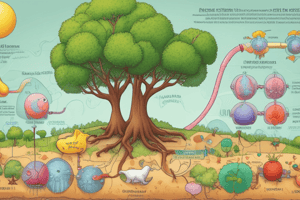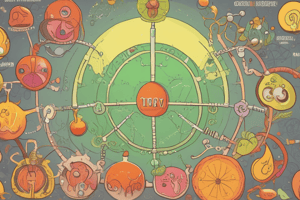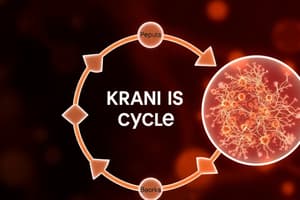Podcast
Questions and Answers
Which complex in the electron transport chain directly passes electrons from NADH to CoQ?
Which complex in the electron transport chain directly passes electrons from NADH to CoQ?
- Complex III
- Complex I (correct)
- Complex IV
- Complex II
Complex II is involved in the transfer of electrons from FADH2 to CoQ.
Complex II is involved in the transfer of electrons from FADH2 to CoQ.
True (A)
What is the role of coenzyme Q (CoQ) in the electron transport chain?
What is the role of coenzyme Q (CoQ) in the electron transport chain?
To collect and transfer electrons from Complex I and II to Complex III.
The enzyme __________ catalyzes the conversion of succinate into fumarate in the citric acid cycle.
The enzyme __________ catalyzes the conversion of succinate into fumarate in the citric acid cycle.
What is a characteristic of the standard reduction potential of electrons transferred from succinate to CoQ?
What is a characteristic of the standard reduction potential of electrons transferred from succinate to CoQ?
Cytochrome C is an integral part of Complex I.
Cytochrome C is an integral part of Complex I.
What is the primary function of Complex III in the electron transport chain?
What is the primary function of Complex III in the electron transport chain?
Match the following complexes with their respective electron donors:
Match the following complexes with their respective electron donors:
Which molecules transfer electrons between respiratory complexes?
Which molecules transfer electrons between respiratory complexes?
NADH can participate in one-electron transfer.
NADH can participate in one-electron transfer.
What is the final electron acceptor in the electron transport chain?
What is the final electron acceptor in the electron transport chain?
The oxidation states of FMN and CoQ allow them to accept and donate ________ electrons.
The oxidation states of FMN and CoQ allow them to accept and donate ________ electrons.
Match the following proton carriers with their characteristics:
Match the following proton carriers with their characteristics:
Which statement about cytochromes is correct?
Which statement about cytochromes is correct?
Iron-sulfur clusters differ by more than one formal charge based on the number of Fe atoms.
Iron-sulfur clusters differ by more than one formal charge based on the number of Fe atoms.
What influences the sequence of electron transport in the chain?
What influences the sequence of electron transport in the chain?
Cytochrome c is a membrane-bound protein that cannot move freely.
Cytochrome c is a membrane-bound protein that cannot move freely.
What hypothesis explains how electron transfer leads to ATP synthesis?
What hypothesis explains how electron transfer leads to ATP synthesis?
The process by which Complex III produces two molecules of reduced cytochrome c is called the ________ cycle.
The process by which Complex III produces two molecules of reduced cytochrome c is called the ________ cycle.
Match the following components with their functions in the electron transport chain:
Match the following components with their functions in the electron transport chain:
Which of the following statements about the proton motive force is true?
Which of the following statements about the proton motive force is true?
Complex IV acts as a monomer and contains six subunits.
Complex IV acts as a monomer and contains six subunits.
The primary role of electron transport chain proteins is to transfer ________ and facilitate ________ transport.
The primary role of electron transport chain proteins is to transfer ________ and facilitate ________ transport.
Flashcards
Electron Transport Chain
Electron Transport Chain
A series of protein complexes that transfer electrons from electron donors to electron acceptors, releasing energy for ATP synthesis.
Electron Donors (NADH + H+ and FADH2)
Electron Donors (NADH + H+ and FADH2)
Molecules that provide electrons to the electron transport chain.
Final Electron Acceptor
Final Electron Acceptor
The molecule that accepts the electrons at the end of the electron transport chain.
Iron-Sulfur Clusters
Iron-Sulfur Clusters
Signup and view all the flashcards
Cytochromes
Cytochromes
Signup and view all the flashcards
FMN and CoQ
FMN and CoQ
Signup and view all the flashcards
Reduction Potential
Reduction Potential
Signup and view all the flashcards
Ubiquinone (UQ)
Ubiquinone (UQ)
Signup and view all the flashcards
Complex III
Complex III
Signup and view all the flashcards
Q Cycle
Q Cycle
Signup and view all the flashcards
Complex IV (Cytochrome c Oxidase)
Complex IV (Cytochrome c Oxidase)
Signup and view all the flashcards
Chemiosmotic Hypothesis
Chemiosmotic Hypothesis
Signup and view all the flashcards
Proton Motive Force
Proton Motive Force
Signup and view all the flashcards
How is ATP Synthesized?
How is ATP Synthesized?
Signup and view all the flashcards
Electron flow direction
Electron flow direction
Signup and view all the flashcards
Electron Transport Chain (ETC)
Electron Transport Chain (ETC)
Signup and view all the flashcards
CoQ (Ubiquinone)
CoQ (Ubiquinone)
Signup and view all the flashcards
Standard Reduction Potential
Standard Reduction Potential
Signup and view all the flashcards
ATP Synthesis Coupling
ATP Synthesis Coupling
Signup and view all the flashcards
Proton Gradient
Proton Gradient
Signup and view all the flashcards
Study Notes
The Citric Acid Cycle (CAC)
- Also known as the Krebs cycle or TCA cycle
- A series of 8 chemical reactions
- Releases stored energy through the oxidation of acetyl coenzyme A (acetyl-CoA) derived from carbohydrates, fats, and proteins
- Catabolic process, involving degradation
- Major free energy conservation system in most organisms
- Amphibolic (both catabolic and anabolic), as some pathways use intermediates for biosynthesis
- Ancient component of metabolism
- Enzymes localized in the mitochondrial matrix (except succinate dehydrogenase, which is in the inner mitochondrial membrane)
Citric Acid Cycle Functions
- Accounts for the major portion of carbohydrate, fatty acid, and amino acid oxidation
- Generates precursors for the biosynthesis of fatty acids, steroids, porphyrins, purine and pyrimidine nucleotides, and certain amino acids
Reactions of the Cycle
- Citrate Synthase: Condensation of acetyl-CoA and oxaloacetate to yield citrate
- Aconitase: Rearranges citrate to isocitrate
- Isocitrate Dehydrogenase: Oxidative decarboxylation of isocitrate to α-ketoglutarate, producing the cycle's first CO₂ and NADH
- α-Ketoglutarate Dehydrogenase Complex: Oxidative decarboxylation of α-ketoglutarate to succinyl-CoA, producing a second CO₂ and NADH.
- Succinyl-CoA Synthetase: Conversion of succinyl-CoA to succinate; a substrate-level phosphorylation reaction forming GTP from GDP and Pi
- Succinate Dehydrogenase: Oxidation of succinate to fumarate, reducing FAD to FADH₂. This enzyme is embedded in the inner mitochondrial membrane
- Fumarase: Hydration of fumarate to malate
- Malate Dehydrogenase: Oxidation of malate to oxaloacetate, producing NADH
Net Result of Cycle
- Per Acetyl-CoA molecule: 2 CO2, 3 NADH, 1 FADH2, 1 GTP (converted to ATP)
Regulation of the Citric Acid Cycle
- Complex regulation; rate-controlling enzymes include citrate synthase, isocitrate dehydrogenase, and α-ketoglutarate dehydrogenase
Electron Transport and Oxidative Phosphorylation
- Catabolism of carbohydrates, lipids, and proteins feeds into the CAC
- CAC is the major source of reduced electron acceptors NADH and FADH₂.
- Final step under aerobic conditions is oxidative phosphorylation
- During oxidative phosphorylation, electrons from NADH and FADH₂ are passed through a series of electron carriers in the inner mitochondrial membrane, ultimately reducing oxygen to water.
Electron Transport Chain (ETC) Components
-
Four respiratory complexes embedded in the inner mitochondrial membrane
-
Associated with various redox-active prosthetic groups (e.g., iron-sulfur clusters, heme groups) with increasing reduction potential.
-
Three complexes (I, III, IV) actively pump protons across the inner mitochondrial membrane from the matrix to the intermembrane space
-
Coenzyme Q (Ubiquinone) and cytochrome c relay electrons between the complexes
-
Electrons flow from NADH/FADH2 to oxygen
-
Two electrons from NADH or FADH2 yield 2.5 or 1.5 ATP.
Chemiosmotic Hypothesis
- Electron flow through the ETC creates a proton gradient (proton motive force) across the inner mitochondrial membrane.
- The electrochemical potential (proton-motive force) provides the energy necessary for ATP synthesis during oxidative phosphorylation
- Protons flow back into the matrix through ATP synthase, driving ATP synthesis.
ATP Synthase
- Enzyme embedded in the inner mitochondrial membrane
- Fo subunit forms a proton channel, and F1 subunit is the enzymatic core
- Rotation of Fo subunit causes conformational changes in F1 subunit leading to ATP synthesis from ADP and Pi
Regulation of Oxidative Phosphorylation
- Regulation is linked to the cell's need for ATP, typically regulated by ADP/ATP ratios
- High ADP stimulates pathway activity; low ADP slows down the process. This is often referred to as acceptor control
Studying That Suits You
Use AI to generate personalized quizzes and flashcards to suit your learning preferences.




